 A couple of weekends ago, I worked my fifth Western States 100 as a medical volunteer. On top of that, this year marks a decade of providing similar medical support and expertise to runners during their herculean efforts to run ultramarathon distances.
A couple of weekends ago, I worked my fifth Western States 100 as a medical volunteer. On top of that, this year marks a decade of providing similar medical support and expertise to runners during their herculean efforts to run ultramarathon distances.
While many best practices in the sport have been refined by both research and shared experience, most continue to lack a definitive evidence basis. This includes how best to pace, fuel, hydrate, and maintain electrolyte balance. But even more tenuous is how to best problem-solve the intense challenges of ultra-distances, namely the big three we medical folks encountered most at this year’s Western States: blisters, cramping, and nausea.
In this article, I’d like to share my first-principles approach for how to best address these big three challenges, and how they’ve played out during this year’s race, and in events past. My hope is this professional perspective will provide a logical strategy to help you through your race-day challenges!
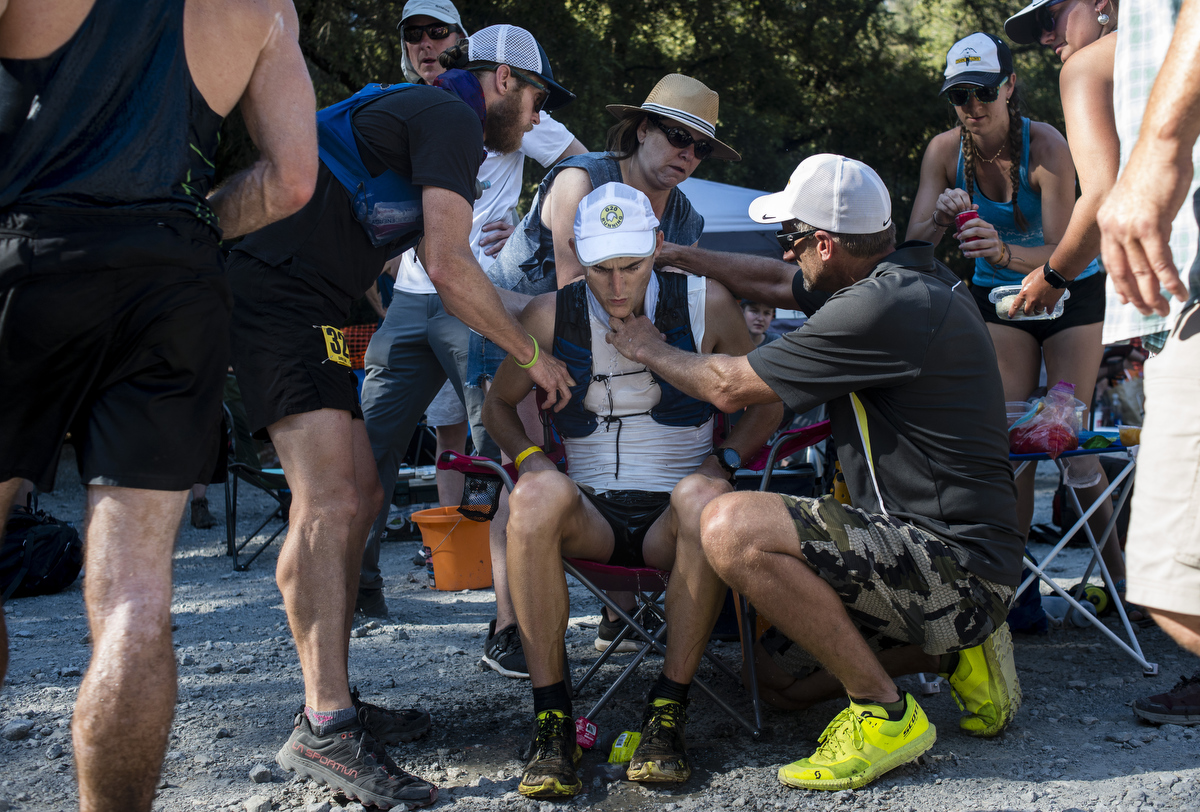
Cody Lind being tended to by his crew before the Rucky Chucky river crossing at mile 78 of the 2021 Western States 100. Photo: iRunFar/Alex Potter
Evidence-Based Information Versus First Principles
Our modern world craves evidence. We want truths: foundations upon which we can place our faith. As such, we as athletes — and even medical professionals and scientists — look for research-substantiated evidence to guide our decision-making. We want our decisions based on published, peer-reviewed research studies that definitively prove the best possible practices.
Yet, that is far easier said than done. Scientific research on ultrarunning, though a quickly growing field, is limited. Research studies, even if peer-reviewed and published, are often lacking in key areas. They might lack applicability across different situations, or not have concept and construct validity.
Does this nutrition study on, say cyclists on spin bikes, apply to mountain ultrarunning? And outcomes observed might not correlate directly with particular variables, or not have internal and external validity. Drinking the pickle juice stops cramps, but what part of the juice or our consumption of it creates that effect? And is that effect expected across all endurance situations?
As such, in our desire for evidence, we tend to over-generalize the effects and apply them to too many people and situations. What if, instead, we relied on something more foundational than a narrow band of research studies?
First principles is a concept whereby decisions are based on fundamental knowledge and logical thinking of a particular situation. It is believed that Aristotle first coined this term, and defined it as “the first basis from which a thing is known.” It is the ground-level understanding of any concept.
When addressing most ultrarunning challenges — both in the clinic and on the run — I lean far more heavily on first principles than evidence-based research. Because when using foundational knowledge of first principles, there are few issues with validity.
As such, when addressing the challenges of blisters, nausea, and cramping, my solutions distill to first principles. Below are those strategies, and anecdotes of their application.
Blisters
I volunteered this year at the Devil’s Thumb aid station. It sits at mile 47, atop what is the steepest down-and-up traverse on the Western States course. By the time runners arrive at Devil’s Thumb, they’ve covered 30 miles of the rugged Sierra Nevada high country, and cruised a gradual half-marathon downhill before plummeting into a steep, technical descent of Deadwood Canyon. As such, this aid station represents a pivotal time and place to restore and repair.
Blisters, toenail issues, and other foot pains represent a major challenge in ultrarunning. Much focus is placed on optimal shoe and sock selection, as well as the application of various powders, lubricants, and coverings to prevent and treat skin irritation that can cause tremendous pain and stop runners in their tracks.
Yet a key ingredient in blisters — besides moisture, which softens the skin, and shoes, socks , and dirt, which can irritate the skin — is friction. And friction is the outcome of a mechanical process of how the foot interacts within the shoe, sock, and ground.
As such, blister formation and toenail pain and prevention is inherently a running stride issue. How one lifts the foot and then strikes the ground is the key issue that creates the energy to rub a foot within or slam one’s toes against a shoe.
One woman came into Devil’s Thumb in severe foot pain. Emotionally distraught, and riddled with blisters on her toes and forefoot, she feared that she would be unable to make it through the next canyon.
Besides doing my very best Liza Howard-inspired treatment of her feet, which included tactical blister drainage and crease-free taping, I instructed this woman — running her first Western States, with family and friends from her home state of Wisconsin waiting in Michigan Bluff at mile 55 to see her — to do her best snow running impression: “Pretend you’re running through four inches of snow,” I told her. Doing so enhances hip flexion, improves foot-under-body landing, and substantially decreases the shearing forces of the foot inside the shoe.
This strategy is incredibly effective because it uses first principles — identifying the forward-sliding shearing force of the foot within the shoe — to make a significant change to reduce or eliminate that force. This is the reason that, anecdotally, blister issues are relatively rare among the elite field at Western States. Any other approach — including taping, new socks, different shoes, and pain relievers — only ignores or attempts to block or absorb that propagating shear force.
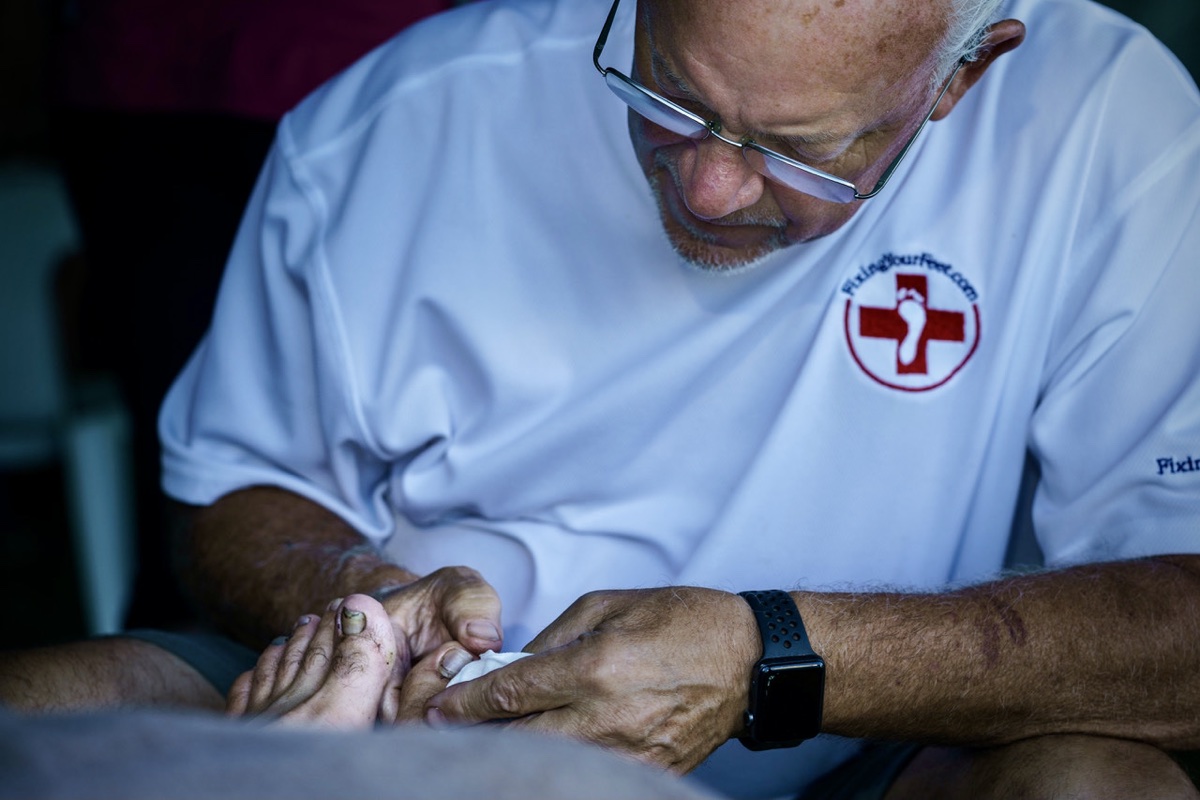
“Fixing Your Feet” author John Vonhof tending to an athlete at the 2018 Western States 100. Photo courtesy of John Vonhof.
Cramps
Mid-run cramping is a frustrating, perplexing, and poorly understood challenge during endurance events. While evidence exists that variables such as hydration, electrolytes, and food intake can mitigate cramps, both research and runner experience consistently show that cramping can persist even when those fueling bases are addressed.
Scores of runners entered Devil’s Thumb with severe cramps. I, too, have experienced race-ending leg cramps at Western States. Many approached medical wishing for specific foods, as well as orthopedic care to massage and stretch those ailing muscles.
Having researched this concept thoroughly for a previous iRunFar article, I am both familiar with the current research evidence on what works and what doesn’t, as well as the first principles behind why cramping occurs:
- Cramping is a neurological phenomenon, whereby the brain perceives a muscle is being over-strained either in the intensity with which it is being used, or the specific movement pattern of the muscle and limb.
- Theoretically, cramping is a neuro-protective way to get us to slow down or stop. Doing so will therefore preserve the integrity of the muscle and maybe our entire physiological system.
This represents first-principles knowledge of cramping. As such, even though cramping can be mitigated slightly by hydration, calories, and salt, the most effective strategies include slowing down, stretching, and gentle movement.
Slow Down
Decreasing exercise intensity is huge. Relaxing the neurological system that drives the cramping is the foundational step. This is why runners who rest are more likely to recover from cramps than those who attempt to stubbornly press onward.
Stretch
Cramping often results from muscles moving both inefficiently and insufficiently. For example, if a runner fails to adequately lift their leg high enough and instead runs in the ultra-shuffle, this often keeps the hamstring chronically long and the quad chronically shortened. Passive stretching is a short-term method to restore full lengthening to stiff, shortened, and beat-up muscle tissue.
Move Slowly, Gently, and Persistently
There was a tendency among cramping runners at Devil’s Thumb to remain sitting or lying down for prolonged periods. While rest is key, too much is detrimental. Supple, pliable muscles are crucial for efficient movement. Once active cramping has abated, some stretching undertaken, and other foundational needs addressed, I instructed runners to get moving, first, by walking around the aid station, and then by walking back onto the trail and continuing their race!
Logistically, runners leaving Devil’s Thumb had a flat, rolling, then gradual two miles before embarking on another deep canyon, El Dorado Canyon. I instructed them first to walk, actively stretching out the hips, pushing off assertively with the feet, and otherwise moving forward at a low intensity. I also recommended deep breathing to keep the neurological system calm.
After a mile or two of no cramping, they would reach that initial descent. There, I said, they should do their best Jim Walmsley impression and run with big, active hips, providing active mobility to the legs.
Run Efficiently
The ideal, balanced strategy to both decrease and prevent cramping is to run with a hip-centric, circular stride that allows full, reciprocal lengthening and shortening. This represents optimal muscle function: fully contract and shorten, fully relax and lengthen. While this is obviously best practiced over many months and years preceding race day, it can still be employed as a strategy, once mid-race cramping kicks in. This, too, falls under the cue of running through four inches of snow.
These strategies, again, address the first principles of cramping: moderating neuromuscular intensity and movement efficiency. Multiple cramped runners at Devil’s Thumb were thus able to recover and make it to the finish line in Auburn for a buckle.
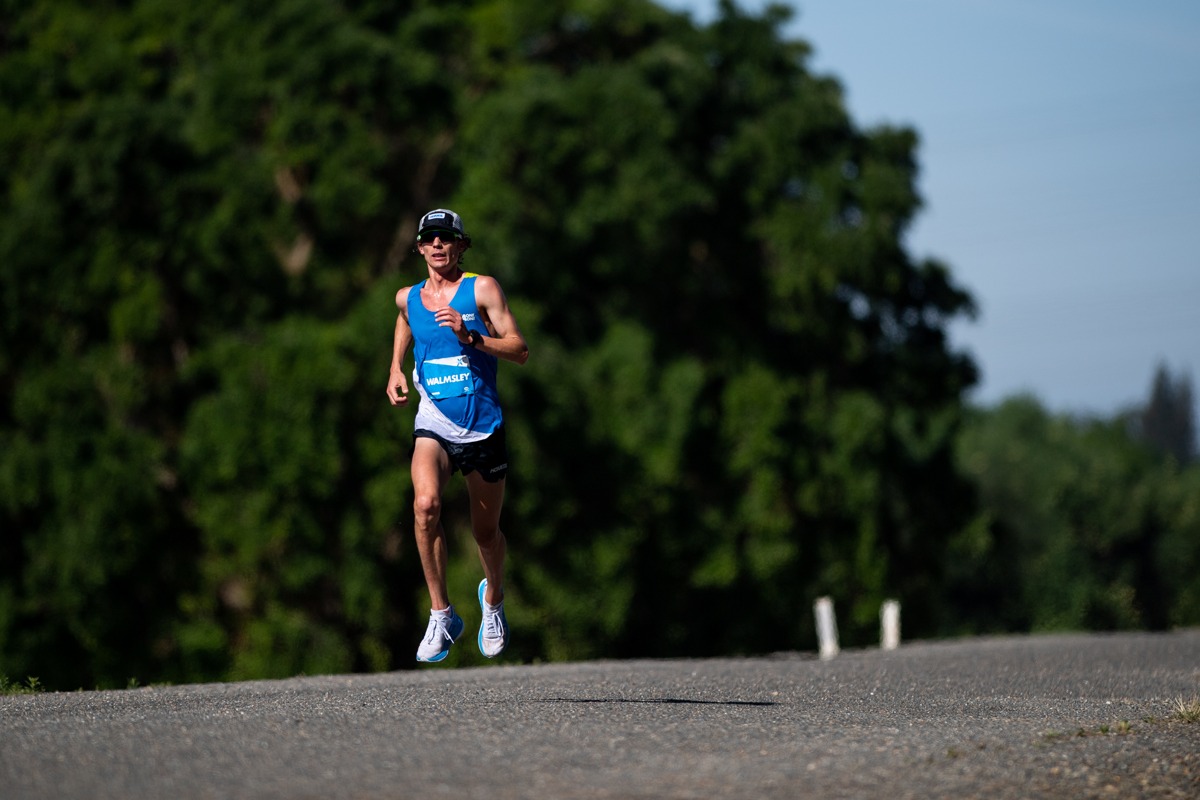
Jim Walmsley airborne at the 2019 Hoka One One Project Carbon X. He runs with a long open stride and lifts his legs sufficiently off the ground to allow for muscle lengthening. Photo: Hoka
Nausea
This might be the biggest challenge that befalls ultrarunners, especially at Western States. The gastrointestinal (GI) system — so crucial for water and nutrient intake — is susceptible to shutdown by several factors. And once irritated, it can remain so for a long time, if not the duration of the event.
That nausea is so common in events like Western States, and for so many runners, makes it even more frustrating that — despite advances in nutrition and other supplementation — it remains such a stubborn issue.
Perhaps it is a lack of understanding of first principles that is a barrier to its treatment and prevention.
Nausea results from the impaired function of the GI system. Ironically, this impairment isn’t a bug of the GI system design, it is a feature. In fight-or-flight survival situations, GI function is considered extraneous, if not compromising, to our survival.
In such high-intensity situations, blood is shunted away from the GI system and toward more key organs, such as the heart, lungs, and nervous system, as well as muscles, and the GI organ functions are down-regulated in favor of systems that will acutely allow us to fight or flee to safety.
You can see the challenge of endurance events with both intensity and duration: our GI system is likely to naturally shut down while we still need it for nutrient intake!
While a certain degree of GI system inhibition is inevitable, a few factors will inhibit it more acutely. These include:
- Running too intensely. The more our flight system is activated, the more the GI system is inhibited.
- Dehydration. The smooth muscle tissue comprising our stomach and intestines requires a lot of water for optimal function. The body will “steal” water from these organs if there is insufficient hydration for the working mover muscles.
- Heat. High external temperatures cause the body to shunt blood flow away from all internal organs, including the GI system, in order to cool the body and dump heat along the body’s surface. Less blood flow inhibits GI function.
Thus, any strategy to prevent and mitigate nausea caused by GI shutdown must address these key factors.
Then, once the GI system has been inhibited, any water or nutrient intake is more likely to cause internal irritation of the inner lining of the system. Irritation can be both mechanical and chemical:
- Mechanical irritation. Foods and fluid that are quickly processed in an efficient GI system instead fail to pass through, and instead bounce and slosh around the stomach and intestines.
- Chemical irritation. Certain foods and fluids that are easily digested in a functioning GI system often present problems when it is inhibited. Acidic fluids like soda, or spicy or higher-fiber foods like chips, pretzels, or bread can become chemical irritants when digestion is impaired.
Consider GI tissue irritation to be somewhat like a blister, where normal, resilient tissue gets sensitized and irritated due to stress. And this irritated GI tissue, like a blister, can remain irritated for a long time!
As such, any effective strategy at nausea mitigation must address two key factors:
- Preventing GI system shutdown and facilitating its reactivation; and
- Avoiding further irritation of sensitized GI tissue.
Yet, anecdotally, at major races like Western States, I fail to see strategies that address these needs. Instead, I consistently see runners stubbornly forcing foods down a sensitized system.
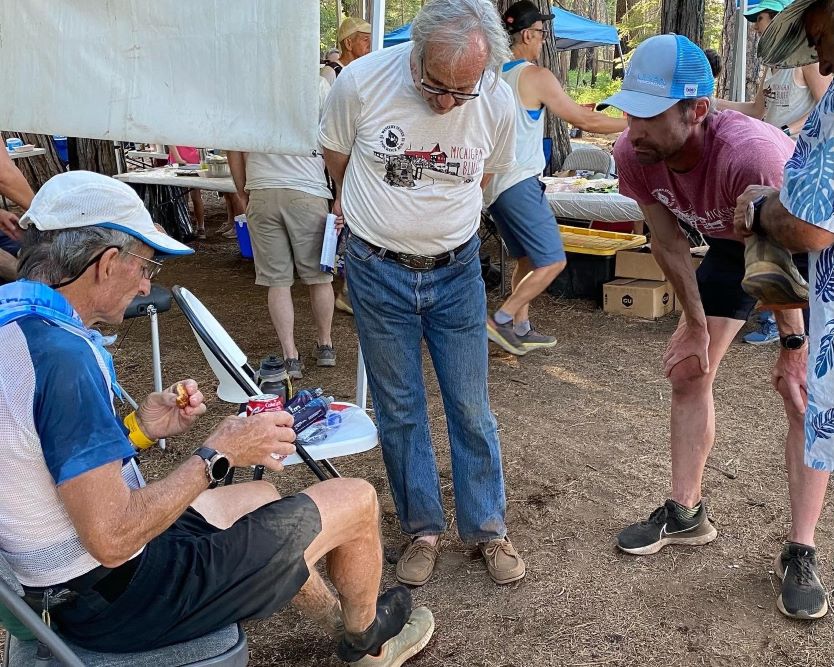
Joe Uhan with a nauseated ’81 and ’83 Western States champion, Jim Howard. Photo courtesy of Joe Uhan
Outcome-Based Strategies for Nausea: Forget the “Puke and Rally” and Go Minimal
The two most significant outcomes of nausea are:
- Impaired water and nutrient absorption; and
- Inability to move forward without discomfort and time spent actually vomiting.
And while nutrient intake is important, the most fundamental factor in finishing a race is … crossing the finish line. The only way to do so is to keep moving forward. As such, any strategy that stops vomiting and allows forward progress is preferred to one that causes ongoing vomiting.
Such a concept should be neither novel or mind-blowing, yet I anecdotally observe, time and again, runners encourage both more vomiting and a quick resumption of aggressively eating irritating foods. Both strategies only result in further GI tissue irritation and prevent any forward progress.
Why this conventional wisdom persists befuddles me. Perhaps it is the notion that food and water is an absolute requirement for forward movement. That may be, especially for water. But food? What the low-carbohydrate movement of a decade ago taught us is that we need far less calories than we realize. And, when you eat less, you require less water to digest and process those calories.
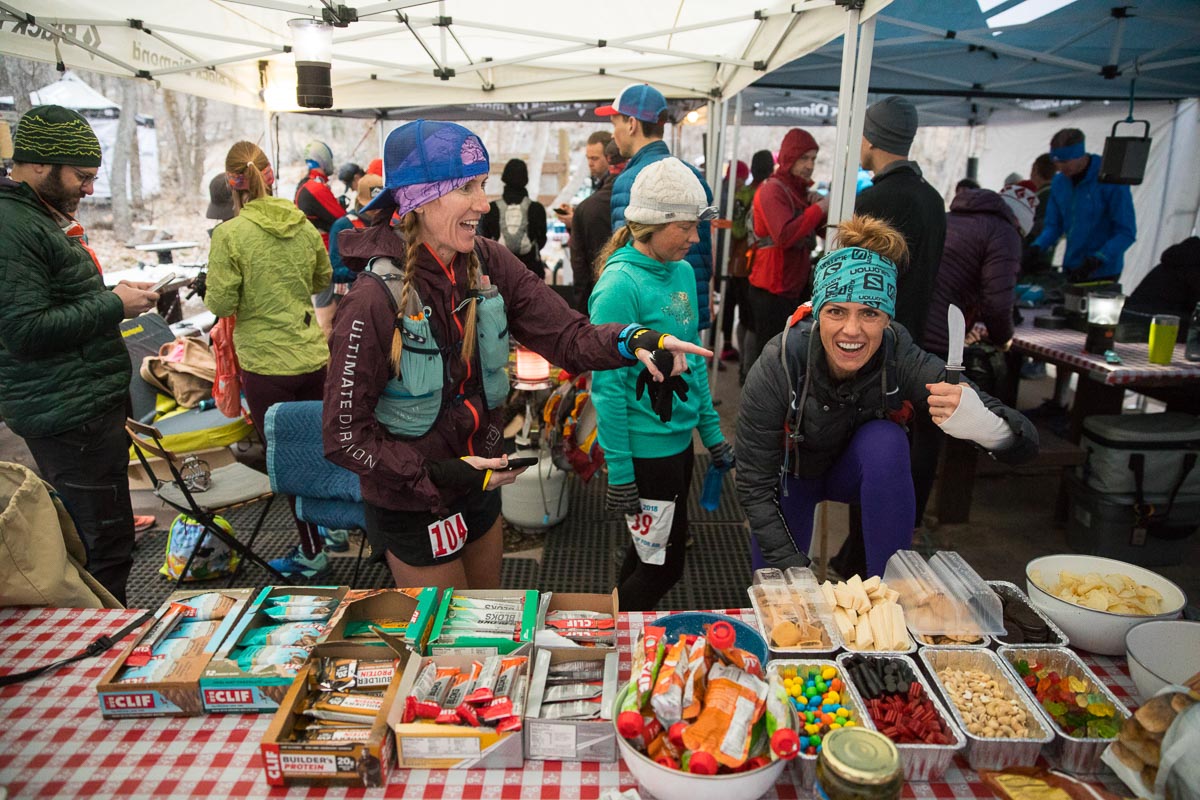
A typical offering of calories in various forms at an aid station at the 2018 Running Up for Air event at Grandeur Peak in Utah. Photo: Andrew Burr
As such, my strongest strategy for nausea mitigation is:
- Slow down. Decreasing performance intensity down-regulates the fight-or-flight system, and — in time — restores both blood flow and activation of the GI system. As with cramping, deep breathing also helps down-regulate an amped system.
- Stop eating! Once the GI tissues have become irritated, they need a break! Much like changing running socks or removing that pebble from your shoe, keeping foods — particularly solids — out of the GI system for even short periods will allow those tissues to repair and improve function. Let go of the “puke and rally” strategy! Be OK without food in your stomach, and you’re far less likely to continue vomiting.
- Sip fluids. For every nauseated runner at Devil’s Thumb, after resting and voiding, I instructed each to leave with two filled bottles: one with water, one with ginger ale.* I then instructed them to take tiny sips of each and only if and when they feel they need it — drinking and fueling to their needs.
*Is this fake-ginger soda actually preferable to any other sugar source? That is uncertain. But liquid calories of any kind are preferred. And in my experience, most runners do not fuel on ginger ale. Thus, when nauseated, it represents a novel, alternative fuel source.
This strategy allows the GI system to become fully functional, decrease tissue irritability and — on its own time — absorb water and nutrients once again. But most importantly? It stops the cycle of vomiting! And while the optimal calorie volume may not be absorbed, it still allows for forward progress.
A Western States 100 Anecdote About Nausea
The most compelling anecdote of this approach occurred during the 2016 race. I was connected with Didrik Hermansen, an elite runner from Norway running Western States for the first time.
When I started pacing him at mile 78, he was in a great position, in third place. However, his first words as we crossed the American River were, “I’ve been vomiting.” Uh oh.
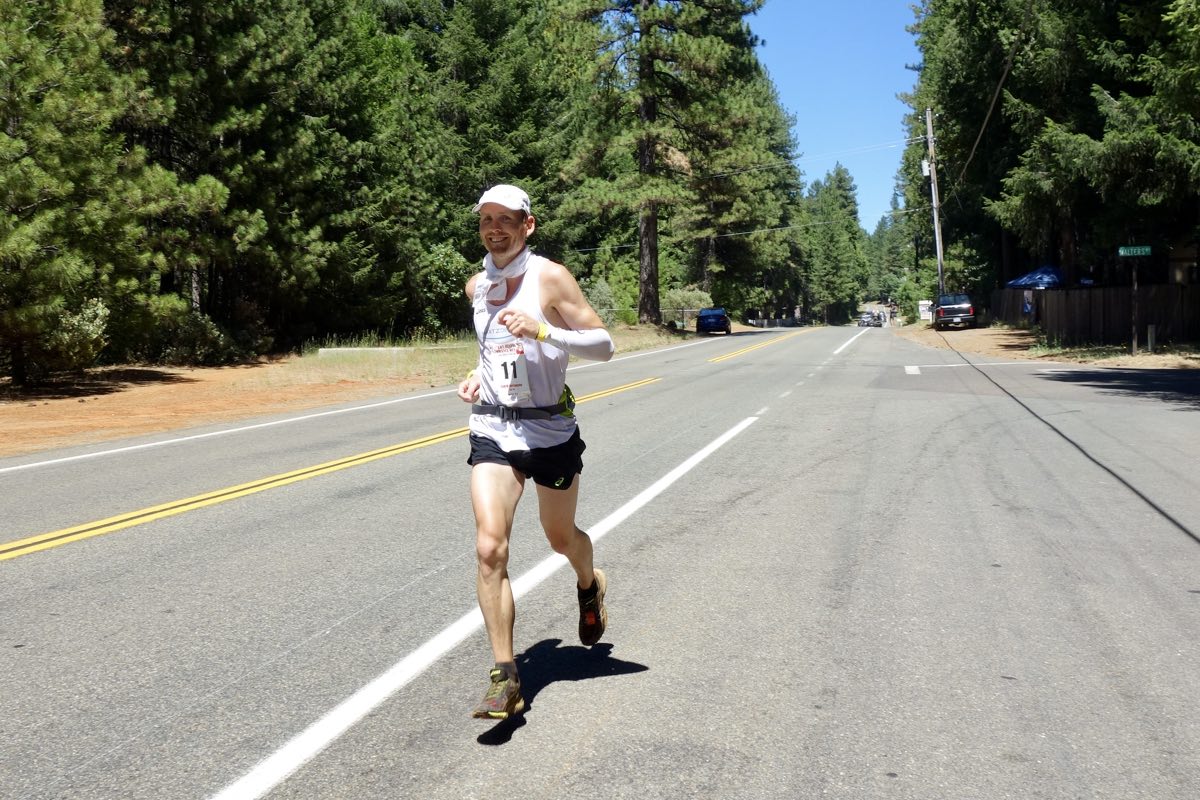
Didrik Hermansen during the 2016 Western States 100 at Foresthill, mile 62. Photo: iRunFar/Meghan Hicks
Across the river, he filled his bottles and ate several pieces of food. Within 200 meters, he vomited up those foods. After several minutes stooped over his feet, he recovered and we methodically moved up the hill.
Once at the top of the climb, I recommended he avoid food, fill his bottle with half water and half ginger ale, and focus only on slowly sipping this mixture. He filled his bottle as such, but grabbed handfuls of food, including higher-fiber fruits. Once again, 200 yards outside Green Gate aid station, he vomited. Meanwhile, I looked behind for other competitors.
After his stomach was empty and the vomiting ceased, he moved well: cruising the flats and impressively bombing any downhill.
This pattern repeated at one more aid station, Auburn Lake Trails, before he finally eschewed food, sticking only to the ginger ale/water mixture, which, interestingly, he barely touched. Yet he ripped off consistent nine-minute miles from miles 86 to 93, and didn’t vomit.
You might imagine my disdain, then, when we arrived at mile 94 aid station, in a strong-but-tenuous second place, well-meaning spectators encouraged him to eat. I ushered him out, with a topped off bottle and no additional food, and he bombed his way down to No Hands Bridge, cruised up to Robie Point, and made his triumphant second-place lap at the Placer High School track in Auburn.
During those final 20 miles, he ingested maybe 200 calories of soda that were actually absorbed. That he finished relatively strong was not in spite of, but because of a lack of food. Because he stopped vomiting, his ailing GI system allowed him to continue running.
That was a powerful, applied lesson in balanced competing needs. I’ve since seen this lesson successfully applied many times, in subsequent nausea challenges. And, so it seems, it was a strategy that helped a few of our ailing runners at Devil’s Thumb make it to Auburn this year as well.
Conclusion
Successfully preventing and mitigating major in-race ultrarunning challenges is best done by having the greatest understanding of both the fundamental, or first principles, causes, as well as the strategies that best remove those major stressors — no matter how seemingly difficult or impossible they may be. Indeed, many of the strategies outlined above defy conventional wisdom. But a first-principles approach to any problem will seldom lead you astray.
Call for Comments
Have you tried any of these solutions to these common mid-race problems? How did you find them?
